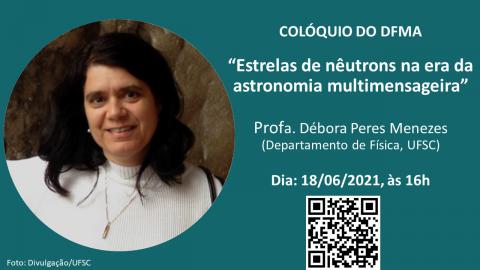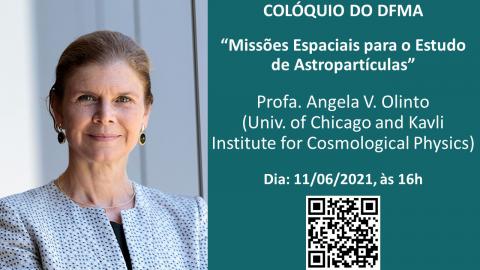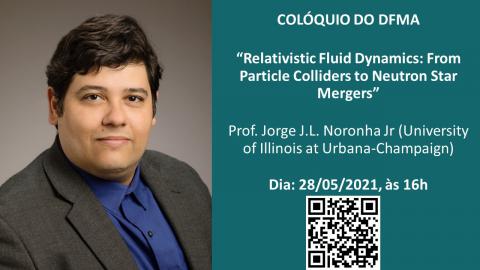
Transmissão ao vivo via YouTube e Zoom.
Resumo: A primeira detecção de uma estrela de nêutrons ocorreu em 1967. Sabe-se hoje que essas estrelas são objetos muito compactos com raios da ordem de 10 km e massas que vão de 1,4 a mais de 2 massas solares. Na verdade, são remanescentes estelares de estrelas massivas, uma espécie de zumbis estelares (morrem, mas não completamente). Nas últimas décadas, observações astronômicas geraram vários vínculos para massas das estrelas de nêutrons. Finalmente, em 2017, as primeiras ondas gravitacionais geradas pela fusão de duas estrelas de nêutrons que faziam parte de um sistema binário, foram detectadas pela colaboração LIGO-Virgo, e também por meio de emissão de raios-X, raios-gama, ultravioleta, infravermelho, no rádio e até no visível, dando início a era da astronomia multimensageira. Para entender as estrelas de nêutrons, equações de estado que satisfazem propriedades nucleares bem definidas são necessárias. E agora, elas podem ser calibradas por meio de vínculos observacionais que delimitam também os raios desses pequenos objetos compactos.
Nesse seminário, vou tentar mostrar como o minúsculo mundo da física nuclear e seus modelos pode ser útil no entendimento do cosmos, por meio de remanescentes estelares que geram, ao se fundir, ondas gravitacionais, por fim, detectáveis.

Transmissão ao vivo via YouTube e Zoom
Resumo: A meta da física de astropartículas é estudar a física de partículas através de observações cósmicas e sistemas cósmicos através de observações de partículas. Nas últimas décadas o nosso grupo tem se dedicado a descobrir a origem das partículas mais energéticas detectadas até hoje: os raios cósmicos e neutrinos ultra energéticos. Estudamos a astrofísica básica das possíveis origens e a propagação destas partículas. Desenvolvemos projetos observacionais tanto com observatórios no solo quanto no espaço. Vamos rever o progresso na última década e os projetos para a próxima década nesta área de astropartículas.

Transmissão ao vivo via YouTube e Zoom
Resumo: Heavy-ion collision experiments have provided overwhelming evidence that quarks and gluons, the elementary particles within protons and neutrons, can flow as a nearly frictionless, strongly interacting relativistic liquid over distance scales not much larger than the size of a proton. On the other hand, with the dawn of the multi-messenger astronomy era marked by the detection of a binary neutron star merger, it became imperative to understand how extremely dense fluids behave under very strong gravitational fields. Therefore, three of the most cutting-edge experimental apparatus in modern science, the Relativistic Heavy Ion Collider (RHIC), the Large Hadron Collider (LHC), and the Laser Interferometer Gravitational-Wave Observatory (LIGO) are now taking data whose description requires a major overhaul of our current understanding of fluid dynamics. In this colloquium I will discuss the new developments that have contributed to redefine the onset of relativistic fluid dynamics and its extension towards the far-from-equilibrium regime. New results involving viscous fluids and their coupling to general relativity will also be presented. These results pave the way for the inclusion of viscous effects in neutron star merger simulations.

Transmissão ao vivo via YouTube e Zoom.
Resumo: Com observações cuidadosas e sistemáticas do céu, há muito tempo, o Homem vem construindo e refinando o seu conhecimento. As grandezas observacionais sobre as quais repousa a Astronomia foram, finalmente, abundantemente medidas e com precisões inimagináveis graças à Missão Espacial Gaia da Agência Espacial Europeia. Com seus três “data releases” (2016, 2018 e 2020), temos, hoje, em nossas mãos dados observacionais em quantidade e com qualidade com as quais até bem pouco tempo nem sonhávamos. Entre eles, a grandeza mais importante de toda a Astronomia: a distância de mais de um bilhão e meio de estrelas que nos permite dizer onde se encontram, como são e como dançam, iniciando assim, uma nova era no estudo do Universo. Esses dados, disponibilizados para o mundo todo ao mesmo tempo, representam uma alteração radical na base do conhecimento astronômico e deverá sustentá-lo nos próximos 20-40 anos. Colegas de todas as partes do mundo estão mergulhados nesse oceano de posições, movimentos, brilhos, cores etc., confirmando, revendo e refinando o que sabemos e prestes a enfrentarem, uma vez mais na história, o novo. Fica aqui, o convite para conversarmos sobre essa nova realidade da Astronomia e sobre esse momento histórico que estamos vivendo.